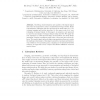Free Online Productivity Tools
i2Speak
i2Symbol
i2OCR
iTex2Img
iWeb2Print
iWeb2Shot
i2Type
iPdf2Split
iPdf2Merge
i2Bopomofo
i2Arabic
i2Style
i2Image
i2PDF
iLatex2Rtf
Sci2ools
102
Voted
ISVC
2009
Springer
2009
Springer
Wavelet-Based Representation of Biological Shapes
Modeling, characterization and analysis of biological shapes and forms are important in many computational biology studies. Shape representation challenges span the spectrum from small scales (e.g., microarray imaging and protein structure) to the macro scale (e.g., neuroimaging of human brains). In this paper, we present a new approach to represent and analyze biological shapes using wavelets. We apply the new technique to multi-spectral shape decomposition and study shape variability between populations using brain cortical and subcortical surfaces. The wavelet-space-induced shape representation allows us to study the multi-spectral nature of the shape’s geometry, topology and features. Our results are very promising and, comparing to the spherical-wavelets method, our approach is more compact and allows utilization of diverse wavelet bases. 1 Literature Reviews Imaging, representation, geometric modelling and topological characterization of shape and form are important components ...
Applied Computing | Biological Shapes | ISVC 2009 | Multi-spectral Shape Decomposition | Study Shape Variability |
Related Content
| Added | 26 May 2010 |
| Updated | 26 May 2010 |
| Type | Conference |
| Year | 2009 |
| Where | ISVC |
| Authors | Bin Dong, Yu Mao, Ivo D. Dinov, Zhuowen Tu, Yonggang Shi, Yalin Wang, Arthur W. Toga |
Comments (0)

